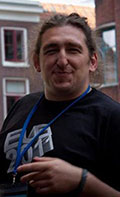نسخه فارسی
Interview by: Amid Rajabi

Hi Hristo! We hope you’re doing well.
Tell us a little about yourself. How did you get interested in 3D and how did it all begin?
It was a career switch for me - after studying computer science for a few years and working on a couple of jobs, first as IT and then at an email security company, I felt I should be doing something else, and I changed universities for one that had a computer science with computer animation program. I had never done CG before that, so I started slow, but I got hooked up and eventually left the university to continue education by myself. The online communities are great, especially CGTalk which became my home, with all the great guys in the 3DS Max effects area. They helped a lot, and my work was improving quickly. I was learning general CG, and eventually I got several arch-viz projects that were paying for my FX study, and after a few bad reels I was lucky to get a call from Mohsen Mousavi, an FX supervisor in Pixomondo Berlin, and I jumped on the first plane

Would you please tell us about Pixomondo? When did you join this company and what’s your current position there?
I joined in Feb 2009, and I left in Aug 2011. I was an effects artist on several movie projects, starting with ‘2012’ and going through ‘Sucker Punch’, ‘Hindenburg’ and ‘Red Tails’. I learned a lot on how effects are really done in a professional environment - very different from doing it at home! There were some good friends, lovely places and great experiences on the way.

Tell us about the big projects in Pixomondo established by you and tell us about tasks and responsibilities that you had in those.
I started small in ‘2012’ with elements like snow clouds, snoflakes, sparks, ice chunks and all that interaction type pieces. Then as my skills and the confidence my supervisor had in me was growing, so were the tasks - from breaking a mirror to tearing up airships! Of course, it’s not all about the glory shots - there’s a lot of detail work besides that, which is of great importance - the mentioned interactions, plenty of dust clouds, sparks, debris and fire elements that puzzle into the big picture. But obviously the steel frame/cloth destruction of the airships in Sucker Punch and Hindenburg, and the rigid/soft bodies in the Red Tails train assault were the pinnacle of what I did, and I’m quite proud of how it turned out!

Could you tell us more about your functional Pipeline in Pixomondo?
Of course studio internal information can’t be shared, but generally a pipeline serves to move information between people, files and machines - in every studio. The problems are the same, and there’s only a couple of approaches that are really viable - you can either have a semi-automatic system that relies a lot on the artist to organize and help him with tools, or you go full automated system where everything is done behind the scenes and the artist operates an interface to a pipeline toolset. Both of these have pros and cons and benefit a specific scenario. Generally the bigger the organization, the more it tends to go towards the automated approach - having pipeline programmers becomes affordable and automation benefits grow with the number of artists. But for smaller studios the semi-automated approach is better - they gain flexibility without spending on pipeline developers.

Which software do you use and why have you chosen those Softwares?
3DS Max as a general platform - mainly because of the great community which nurtured me up, and the Max way of doing things that achieves a lot with affordable resources. It’s plugins - from the integrated PFlow, through FumeFX, Krakatoa, Frost, Rayfire, Thinking Particles and all the useful smaller tools, employ the plugin concept to include great capabilities indeed. And lately - Naiad.

Recently there are so many posts of you regarding Naiad observed in different Forums. Tell us a little about this SW and what is the superiority of this software in comparison with similar ones?
I can point at two main strengths. First, it’s brilliant architecture that is building simulations in the way FX TDs/artists think. It’s an open and powerful toolbox that lets you build anything you want. But secondly, it also fits into the ‘doing more with less’ concept - you can get great results with one or a few people working on a project, and it works brilliantly with Max and it’s plugin arsenal - Frost, Krakatoa, VRay, Thinking Particles.

I also attended in fxphd Max202 courses in July which was really fruitful and I truly took the advantages of that. Could you tell us a little about your teaching experience in fxphd and what was the feedback of the attendees in Max202 courses?
I had a great time! As I do more teaching, I become better at it and I get to enjoy it even more. I love the feeling of giving opportunities to people and seeing them make something great from it. Big part of the picture of life, right? I’m doing what the people who taught me did, so it feels natural and fulfilling. There was a lively discussion in the FXPhD forum, and I hope people left it with much more then they came in with, and the response I’ve been getting points in that direction too. I’m happy about it.

Nowadays, there are so many interested people in this field who really mean to start this major, but they don’t know exactly how to begin in this road. Do you have any especial advice for them? How are they going to start?
Everybody’s way is different - I can only say what worked for me. Generally - learn aggressively, take all the chances you get, with all their cost. Be generous, welcoming and energetic towards others, it’s a people business at the core. Learn to love problems, because they are the opportunities to do something better. Sounds like simple philosophy, but it’s not as easy to do! Enjoy working and living, and keep growing in all aspects of life. Can’t go wrong with that
What’s your own idea about online trainings and activities of cgphd website?
I believe in a good mix of free basic training and commercial advanced training, I think cgphd plays a role into that too.
• Thank you very much for your time indeed.
•Thank you for taking the time to interview me!